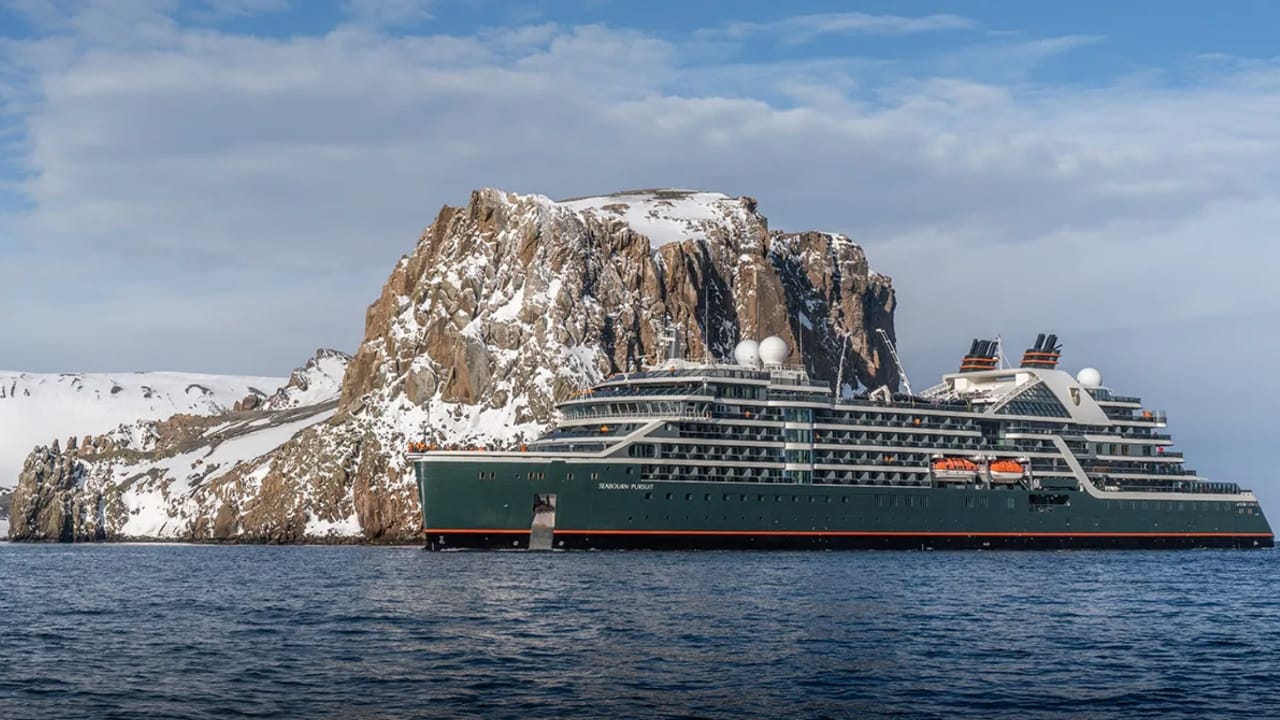An aquatic epidemiologist, a marine mammal scientist, and a behavioural ecologist walk into a bar. That’s not the setup for a punchline; that’s daily life on Seabourn’s new expedition ship, Pursuit.
Launched late last year, the 557-foot by 78-foot Pursuit joins sister ship, Venture, giving Seabourn an edge in the war for Antarctica-bound passengers—last season a record 105,331 people visited the world’s least visited continent (causing some environmentalists concern). While roughly 50 or so cruise ships now serve this market, the ultra-luxe segment is still the tip of the spear. Not only is it really the only way to get here (charters aren’t an option, although you can fly), it’s also where innovation occurs. We went aboard to see what fresh advantages this ship has over the competition.

Seabourn Pursuit carries up to 264 passengers in 132 oceanfront suites (some Antarctic cruises carry 1,000). Better still, each suite comes with downy bedding, 24/7 room service (including caviar—a win), and a state-of-the-art spa that ticks all the best travel boxes. But that’s not why you cross the dreaded Drake down to the Great White Continent.
Wildlife rules the operations in Antarctica, where penguins, seals, and whales are at the top of travellers’ checklists. Therefore, the ship is run more like an adventure safari in Africa than a cruise. The ship’s expedition team consists of 26 Antarctic experts, each specialising in a different fauna. Like Masai trackers, they are on constant lookout.
“When you do a zodiac cruise, it’s the equivalent of sitting in a safari jeep,” says Patrick Demus, the behavioural ecologist onboard Pursuit. “You never know what you’re going to see when you come around the corner.”

And while there’s a variety of incredible species to observe above the icy waters, 95 percent of Antarctica’s wildlife is found below the surface. That’s why aboard both Venture and Pursuit, Seabourn has two custom-made submersibles. Six guests at a time can go up to 980 feet below the surface, a place less than 10,000 people have explored in the history of the world.
“It’s an ancient, alien world where it’s possible we’re seeing species new to science,” says Merel Dalebout, the vessel’s submersible pilot. “Essentially, this is a time machine, seeing the ocean as it was 500 million years ago.”
Although guests won’t see penguins or whales from the submersible, they’ll see cases of polar gigantism, where starfish, sea spiders, and ancient seaweed are larger than creatures in other warmer oceans.
For guests more interested in the feather-filled, squawking variety of animals, there’ll be dozens of opportunities for sightings. Each morning, the expedition takes zodiacs out to scout for a safe landing where guests may witness a giant elephant seal yawn or a skua attacking a penguin rookery. In the afternoon, another zodiac takes you for an hour-long cruise around glaciers and alongside porpoising chinstrap penguins. You might as well call them what they are: game drives.
“You can see the brutality of animal life a lot clearer here; it’s right in your face,” says Demus. “If you watch a wildlife documentary about certain animals, it takes the filmmakers months to get the footage. It feels like what you see in a documentary about Antarctica, you can actually see that when you spend two hours at a colony.”
When you’re back onboard, there’s still plenty of opportunity for animal sightings. Weddell seals, humpback whales, Adélie penguins, and storm petrels are known to make an appearance whether you’re soaking in the ship’s hot tub or sipping TWG Earl Grey during afternoon tea in the Constellation Lounge.
“There’s nothing like the feeling of looking out from the back of a ship and seeing one whale, two whales, three or four,” says marine mammal scientist Rachel Cartwright. “It reassures us that there is a place where all is well, and eco-systems are intact, and whales still swim leisurely by without fear of nets or fishing.

”If they’re not ferrying passengers via Zodiac or giving talks like “A World of Whales: Marine Mammals of the Southern Seas,” scientists like Cartwright are with the guests. They could be chatting about penguin mating seen onshore that day or a pod of orcas that popped up portside with a hot chocolate in hand.
From expedition leaders who have climbed all seven of the world’s highest peaks to kayak guides who have recreated Ernest Shackleton’s historic journey to Antarctica, Seabourn’s crew are arguably some of the world’s most interesting.
Apart from the cozier aspects of the ship, including fur-backed lounge chairs near a bar where glacier ice is chipped for Old Fashioneds, these safari guides at sea shine like an iceberg on a sunny day.

“Our team is there sharing the experiences with you on the mobile classrooms onshore, then back on board in the Discovery Center and in the Expedition Lounge,” says Shaun Powell, director of expedition operations. “Over those shared experiences and the knowledge, it allows guests to continue learning about the wildlife, and it fosters friendships that often continue beyond the voyages.”
Seabourn Pursuit’s all-inclusive 11-day expeditions to Antarctica start at RM41,320 per person for a Veranda Suite based on double occupancy.




